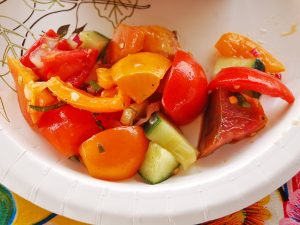“Look around you,” said Eli Zigas. “We’re right next to an interstate, but we’re also in an oasis of green and growth.”
He was referring to Emma Prusch Farm Park, an agriculture preserve of more than 40 acres nestled against the interchange of US 101 and I-680 in East San Jose. Representing the civic planning organization SPUR, Zigas had come to the preserve for a recent panel discussion on urban farming. As the nonprofit’s food and agriculture policy director, he conveyed the message that officials should open up more land for farming as a means for improving quality of life in the inner city.
“A government that wants strong neighborhoods is going to want to see more places where people can come together,” he said, “and urban agriculture provides that.” As Zigas pointed out, furnishing residents with space to cultivate both crops and community improves public health by promoting good nutrition and outdoor activity.
One new strategy that government can use to achieve these ends emerged in 2013 with the passage of Assembly Bill 551 (Ting). As panelist Ken Yeager explained, the law gives tax breaks for the conversion of vacant lots into sites for agricultural production and animal husbandry. The District 4 supervisor noted that Santa Clara County was the second county in the state to implement AB 551, passing a necessary resolution that allows its cities to create Urban Agriculture Incentive Zones.
As the law nudges more neglected South Bay acreage into cultivation, “we can really be an example to all the counties in the state,” Yeager declared.
Another new law, 2015’s Assembly Bill 234 (Gordon), is further bolstering urban agriculture by making it easier for small-scale growers to sell their produce. According to panelist Zach Lewis, AB 234 took shape with the help of Garden to Table, where he serves as executive director. During the law’s development, his organization met with policymakers to share insights from its Neighborhood Harvest Program, which gathers fruit from the backyard trees of San Jose residents and delivers the yield to local food banks.
“That’s kind of the crux of what we do — we’re really trying to utilize our harvest and farm programs to find weak spots in the food system,” Lewis said. “Government and traditional planning doesn’t really understand how local food systems work… we’re trying to give them the information and tools to make those positive changes, so it’s easier for everybody to grow and distribute more healthy, amazing, delicious food in the city.”
Communication and collaboration between officials and stakeholders will need to stay robust for the South Bay to continue creating opportunities for urban farming to thrive. The Santa Clara Valley Open Space Authority intends to keep up its end of the bargain, according to panelist Marc Landgraf. The external affairs manager reported his agency has documented keen public interest in growing food, since “the residents we serve feel that it’s a very important way to connect to nature.”
The Open Space Authority received this feedback as part of outreach conducted after the passage of Measure Q in 2014. Landgraf said up to a quarter of the anticipated $120 million in total revenue from the measure’s parcel tax ($24 annually for 15 years) will go to the agency’s new Urban Open Space Grant Program, a funding source for agriculture projects and various other needs. Recipients of the program’s inaugural round of grants could be announced as soon as mid-November.
Landgraf emphasized that fortifying open space in the inner city helps advance equity, increasing recreational and educational opportunities for residents who otherwise can’t easily enjoy the benefits of outdoor activity because of issues related to income, transportation, and language.
This notion was echoed by panelist Cayce Hill, executive director of Veggielution, a nonprofit which grows food on six acres at Emma Prusch Farm Park. While the organization churns out mountains of delicious produce, Hill asserted it works just as hard “to break down barriers for our local residents to access all these amazing resources here in East San Jose, to provide a space for people to connect to each other and to reconnect to the land, to give them a strong sense of ownership, and then leverage that sense of ownership to promote and take action in the community.”
Collectively, the vision articulated by Hill and the other panelists felt full of promise. With time, the ideas they shared could spread widely, like seeds carried from that little oasis next to the freeway, ready to take root across the greater Bay Area and beyond.
See the Bay Area Monitor’s Facebook page for more photos from the event.

